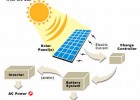Better Manufacturing of Plastic Solar Cells
For the past one and a half decades, researches have been working on improving the technology of plastic solar cells. They have the potential to revolutionize the way we harness solar energy both in terms of efficiency and costs. At Flinders University in Adelaide, South Australia, PhD candidate Anirudh Sharma has been working on improving the manufacturing of build plastic solar cells.
PhD candidate Anirudh Sharma
Image credit: Flinders University
Plastic solar cells have several advantages over traditional silicon-based solar cells, which is what you see in most of today`s solar systems. A lot of energy is required in order to produce high-purity silicon, which accounts for a major part of the costs. This step is not necessary with plastic solar cells. On top of this, they are also flexible and can be directly applied as coating to a wide array of different materials.
In the past, plastic solar cells have been built using a process that involves vacuum conditions, which brings up costs and is lengthy. Sharma`s improved lamination process allows for cheaper and quicker large-scale production of plastic solar cells that perform better:
“In the conventional method of fabricating plastic solar cells you have to deposit various materials sequentially on top of each other in a sandwich structure but over time the materials intermix, leading to device degradation. However my technique involves deposition of materials on two different electrically conductive surfaces, followed by lamination. It gives better control over the material intermixing and thus can give more stable and better performing devices,” says Sharma.
His method is not too different from printing machines. Lamination and printing happens at the same time, which makes the manufacturing process easy to scale. It will be interesting to follow the where Sharma`s technology is a couple of years down the line.
Source: Energy Harvesting Journal








